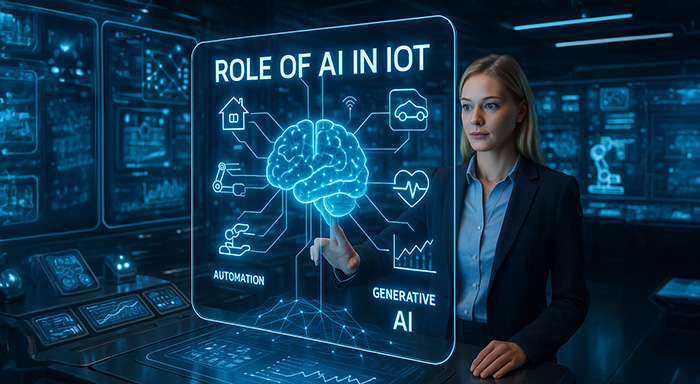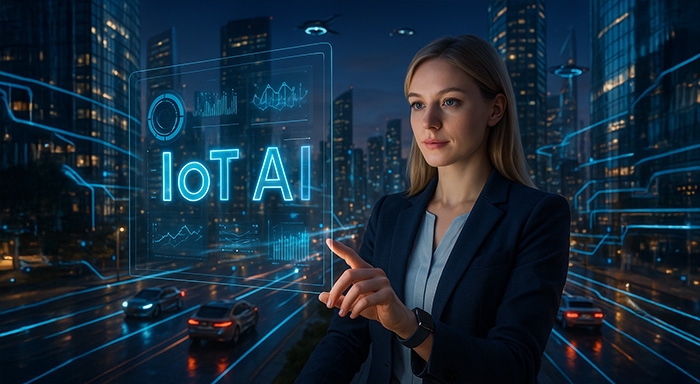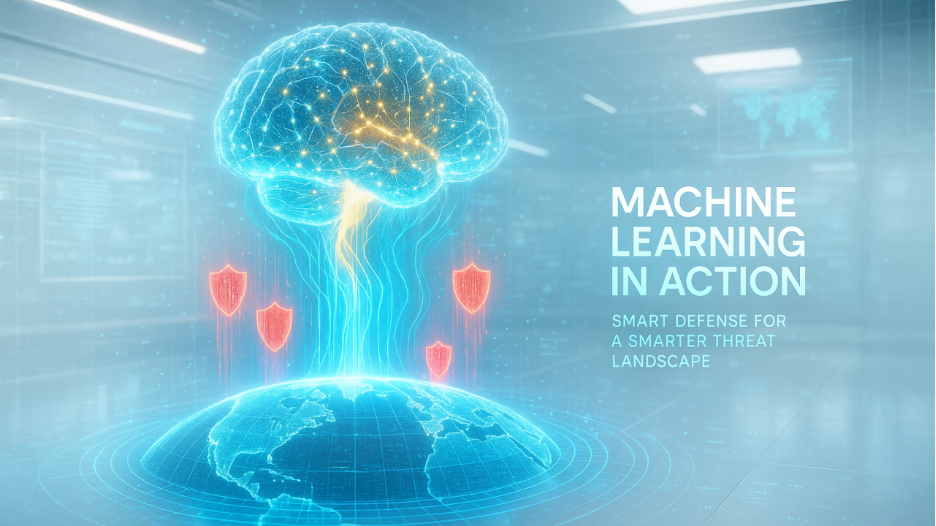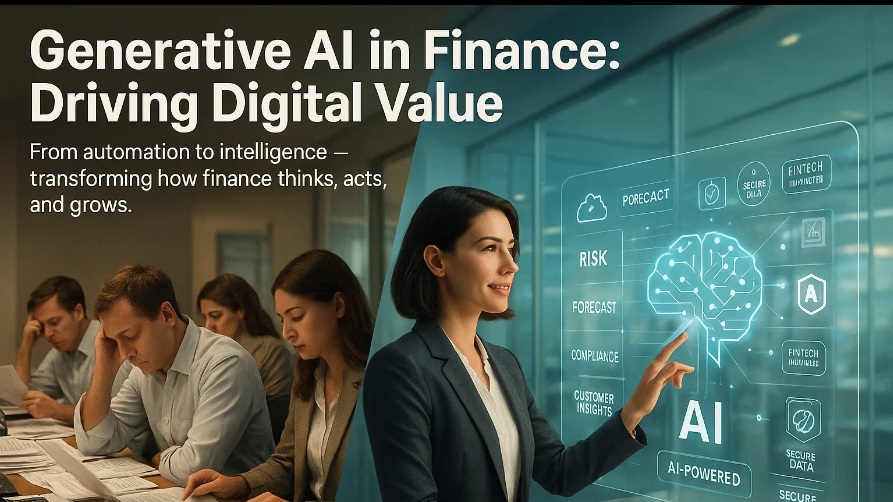Artificial Intelligence (AI) and Internet of Things (IoT) are the two most emerging technologies in recent years. Internet of Things (IoT) is the system of interconnected devices (smartwatches, smart cars
Artificial Intelligence (AI) and Internet of Things (IoT) are the two most emerging technologies in recent years.
Internet of Things (IoT) is the system of interconnected devices (smartwatches, smart cars & homes appliances) over the internet to transfer and receive data. These smart devices can sense the surroundings to interact with each other and collect real-time data.
While AI allows machines to analyze data patterns and make intelligent decisions without human intervention by making use of methods like predictive analytics, machine and deep learning.
AI analyzes data collected by IoT gadgets to automate complicated tasks and make personalized adjustments. Today, the latest technologies are being shaped by AI and IoT, transforming the way we live and work.
Let’s dive into the fascinating world of IoT Artificial Intelligence.
What is IoT AI?
Until recently, the internet was limited to desktops, laptops and smartphones. But now, with IoT almost all appliances can be connected to the internet and monitored constantly. IoT devices collect real-time data about our surroundings and help us get better insights into the working of things around us. It grants remote access to users for managing the devices as per their needs using sensors.
AI creates human-like intelligent machines to perform complicated tasks and reduce burden on humans. This intelligence is incorporated with algorithms and mathematical functions, enables machines to exercise generative learning, reasoning and problem-solving abilities. In short, AI provides machines with the capabilities to adapt, learn, reason and offer solutions in any given situation.
Integration of IoT with AI is paving the way for new and exciting innovations. By blending the power of AI algorithms and the data collection capabilities of IoT devices, intelligent and autonomous technologies are being created. The blending of AI with IoT gives IoT AI, Artificial Intelligence of Things. It allows physical devices to collect and analyze data to trigger actions and make intelligent decisions without any human help. With improved response, monitoring, and analytical capabilities, it is being adopted in almost all industries and domains. From closing doors to endless appliances, IoT AI is being used extensively to enhance efficiency and reduce human effort.
Role of AI in IoT

AI aims to make intelligent machines that can learn and work like humans to automate tasks and improve working efficiency. AI is becoming extremely important in IoT because it can help make sense of large data collected by IoT connected devices and trigger appropriate responses and actions. Let's understand the role of AI in the Internet of Things (IoT):
1. Rule-based Learning
AI systems are equipped with in-built rules or instructions that can be used in IoT applications. For example, an AI system can be set up to turn on the light when the switch is pressed.
2. Machine Learning
It is a subfield of AI that learns behaviors by reading repetitive patterns. It monitors human interaction to make accurate decisions in IoT apps. These IoT AI can help solve difficult problems, automate tedious tasks, and continuously learn to adapt to various situations and processes. For example, in smart homes it is able to analyze the outside weather conditions and depending on it, optimizes heating or air conditioning system to facilitate ventilation.
3. Automation and Control
In IoT applications, AI can automate a range of tasks and make autonomous decisions by managing IoT devices. Take smart vehicles, for example; AI can analyze and process data from sensors to make real-time driving decisions.
4. Inferential AI
Upon collecting data from IoT devices, AI process it to understand the context and derive reasonable deductions. It explains the cause-effect relationship behind phenomena, deduce arguments and reasons and finally draws conclusion. For example, in healthcare domain, it constantly monitors the heart rate of patients and alerts the staff if sensor senses irregular patterns.
5. Generative AI
Generative AI predicts the likelihood of future occurrences by analyzing and reading past data. It predicts new possibilities using existing data as reference to enhance IoT. For example, in industrial IoT applications, AI evaluates the performance of the machines, utilizes data to capture any abnormal behavior or error and predicts maintenance needs, minimizing the repair cost.
Benefits of IoT AI Integration
The combination of IoT and AI brings a wealth of benefits to boost efficiency:
- Data Processing: AI can swiftly analyze and process massive amounts of IoT data in just a few minutes, enabling precise responses and actions.
- Energy Optimization: AI can optimize resource utilization and energy usage in IoT devices, minimizing energy bills in industrial settings and smart homes to improve sustainability.
- Better Risk Management: AI can analyze real-time data from IoT sensors to sense and detect risk factors, trigger alerts, and enable risk mitigation strategies.
- Real-Time Decision Making: AI delivers quick responses and makes smart decisions based on logic and statistics, helping humans navigate complex situations.
- Threat Detection: AI identifies unusual patterns in IoT systems, working to prevent failures, thwart cyberattacks, and block any suspicious activities.
- Improved Efficiency: IoT lacks intelligence and needs AI to analyze the collected data to make sense of it. The processed data is then used to enhance overall working efficiency.
Real-World Applications
AI-powered IoT is consistently revolutionizing the ways we work and live across all domains. These are some real-life examples:
- Smart Cities: IoT AI is incredibly useful in smart cities because it controls and regulates traffic, manages waste production, and maintains a sustainable environment.
- Healthcare: In the healthcare domain, AI-driven devices keep an eye on the patient’s health and constantly monitor the heart rate. It immediately sends signals to staff in case of irregular heart rate to prevent the worsening of disease.
- Agriculture: In the agricultural field, AI in IoT keeps an eye on soil temperature and its condition and sends a signal when a crop needs water to enable automatic sprinklers as per requirements.
Manufacturing & Industry: AI-driven IoT in the industrial sector focuses on maintaining the proper working condition of machines and detects any sort of failures in them before they happen. This gives businesses time to repair it before it worsens. - Retail: IoT devices gather insights into customer shopping habits, favorite products, and foot traffic, while AI analyzes peak shopping times and product demand and suggests items that customers are likely to want.
Overcoming Barriers: Challenges in IoT AI Integration
The increasing collaboration between AI and IoT is also facing many challenges that must be addressed to ensure fruitful implementation. Some of the major challenges are:
- Security & Privacy Risks: Several IoT devices that are installed in an unsafe environment often become an easy target for cyberattacks and hackers, exposing sensitive information of users to risks.
- Data Overload: IoT devices generate and collect a huge amount of data on a regular basis, which can be overwhelming and hard to manage and process for businesses that lack proper AI analytical tools.
- Interoperability: IoT devices can differ depending on the manufacturer's standards and protocols. This poses a challenge for devices to communicate with each other.
- Power Consumption: AI algorithms need a significant amount of power to run and perform computational tasks, while IoT devices are mostly battery driven. This makes power consumption an important factor to consider.
- Cost and Pricing: To implement IoT AI, required hardware and software can be costly, especially for small and medium businesses.
Future of IoT AI: Innovations That Will Shape Tomorrow
As more IoT devices are increasing continuously, the future looks more promising than ever, with new innovations and developments coming along.
One of the most promising use cases of AI in IoT is predictive maintenance. AI can detect any abnormal behavioral pattern by analyzing the data from sensors embedded in a machine or device before they occur. This equips teams with the ability to adopt appropriate measures in time to prevent downtime and repair costs. Improving energy efficiency and safety in industrial settings is another significant domain where IoT AI can thrive.
Some of the key future trends also include edge computing, blockchain, and sustainability. Edge computing allows data to be processed and analyzed much closer to the source of data, minimizing response time. Whereas blockchain is being explored to improve security and ensure privacy more effectively. Sustainability is also a growing future concern, as businesses look for innovative ways to reduce their carbon footprint and negative impact on the environment.
The future of AI and IoT seems exciting, and as more new technologies are emerging, businesses need to be prepared to adapt and adopt these transformative advancements effectively.
Conclusion
IoT AI is shaping the ways we live our lives. AI is the brain, IoT is the body, and together they form an intelligent ecosystem to improve our lifestyle in countless ways. IoT generates tons of data, but AI gives it meaning. As more IoT devices team up with AI, our world is going to get way smarter and more connected. We are on the verge of a new era where technology seamlessly integrates into our lives. This is just the beginning; as these technologies continue to evolve, we can expect even more innovative solutions to integrate into our daily lives.
Read More:
Pro Reed Com Tech Tales: Exploring the Future of Smart Innovation
How iofbodies.com Applications are Transforming Modern Life
Respond to this article with emojis






